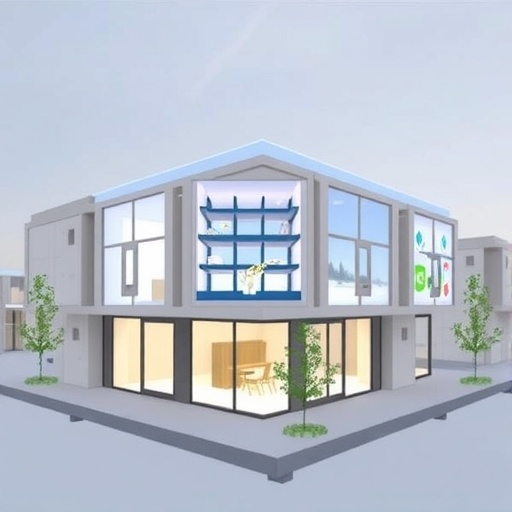Relocatable modular buildings (RMBs) have emerged as a revolutionary concept in construction, representing a shift towards greater flexibility and sustainability in architectural practices. In an era marked by rapid urbanization and the pressing need for efficient resource management, these structures offer a compelling solution by enabling quick assembly from prefabricated units. This modular approach not only streamlines construction processes but also significantly reduces both costs and environmental impacts, presenting a cleaner, safer alternative to traditional building methods. However, the evolving landscape of relocatable modular construction brings forth substantial challenges in managing the logistics of these assets across their multiple lifecycles.
A team of researchers, led by the innovative mind of Associate Professor Yonghan Ahn from the School of Architecture & Architectural Engineering at Hanyang University ERICA, has taken monumental strides in addressing these challenges. Their groundbreaking work revolves around a digital twin (DT)-based framework specifically designed for the facility management of RMB projects. In essence, digital twin technology encapsulates a digital replica of physical assets, seamlessly integrating real-time data analytics and predictive modeling to improve decision-making processes. As Prof. Ahn elaborates, while the application of digital twins is gaining traction across various sectors, its potential in modular construction remains largely untapped.
The newly developed Digital Twin-Enabled Facility Management System (DT-FMS) provides an innovative approach to the management of RMBs. Central to this system is its capacity to aggregate and analyze data from several sources, including building information modeling (BIM), the Internet of Things (IoT), and geographic information systems (GIS). Each of these technologies offers unique advantages that, when combined, facilitate a comprehensive virtual representation of relocatable modular structures. The BIM aspect provides sophisticated three-dimensional models enriched with extensive building information, thus laying the foundation for intricate planning and visualization. Meanwhile, IoT introduces real-time sensor data, enriching the framework with instantaneous insights into the operational status of the building components.
.adsslot_6BRKHF0CdW{ width:728px !important; height:90px !important; }
@media (max-width:1199px) { .adsslot_6BRKHF0CdW{ width:468px !important; height:60px !important; } }
@media (max-width:767px) { .adsslot_6BRKHF0CdW{ width:320px !important; height:50px !important; } }
ADVERTISEMENT
Equally important, GIS contributes critical geographic insights, which not only enhance the logistics management of modular units but also empower location-based decision-making. This can be particularly invaluable when planning the relocation of modular buildings to suit changing requirements or community needs. The interplay of these technologies constitutes a transformative advancement in how facility management is approached throughout the lifecycle of modular buildings.
The framework outlined by the research team consists of three core layers: physical, digital, and service. The physical layer is crucial for enabling real-time tracking and facilitating interactions among various physical entities, such as resources, modular units, and personnel including engineers and project stakeholders. This layer essentially creates a connected environment where data flows seamlessly, ensuring decisions can be made based on current and accurate information. In tandem, the digital layer integrates advanced modeling tools, robust data analytics, and unified data management practices, providing a coherent framework for understanding and improving building performance.
The service layer of this DT-FMS enables users to engage with the digital twin effectively. This interactive platform allows stakeholders to monitor building performance, control operations, and facilitate informed decision-making processes essential for optimizing the operational efficacy of relocatable modular units. For instance, through this system, building managers can execute logistics simulations that anticipate future scenarios, thus preemptively addressing potential challenges in managing the operational lifecycle of the buildings.
The practical application of the DT-FMS framework was showcased through a compelling case study conducted on a relocatable modular school system in South Korea. This case study vividly captured the enhancements in decision-making regarding module distribution and reuse, thereby exemplifying the direct benefits of the framework in improving management efficiency in real-world scenarios. The integration of cutting-edge technology in this context demonstrated how digital twins can provide transformative solutions that are not only efficient but also environmentally conscious.
A significant aspect of this research is its alignment with principles of the circular economy. By advocating for practices of reuse, reconfiguration, and optimal relocation of modular units, the implementation of digital twin technology has the potential to minimize waste in construction projects substantially. This paradigm shift promotes sustainability by ensuring that resources are utilized efficiently and that the lifecycle of construction materials is extended, ultimately maximizing value across recurring project cycles.
In light of this innovative framework, the implications for future construction practices are profound. As urban environments continue to evolve, the demand for adaptable, resilient, and sustainable building solutions will only intensify. The DT-FMS provides a roadmap for integrating advanced technologies into construction and facility management practices, which is imperative for meeting the needs of modern societies. The findings of this research signal a pivotal moment in modular construction, illustrating how the principles of digital twin technology can be harnessed to redefine traditional management approaches in a rapidly changing built environment.
The research team, including significant contributions from Dr. Dennis Nguyen of Hanyang University ERICA, believes that this framework is poised to reshape the construction industry, encouraging researchers and practitioners alike to explore further applications of digital twins in various sectors. Given the advantages that come with integrating digital technologies in construction practices, it is anticipated that the uptake of such systems will gain momentum, fostering innovations that transcend the limitations of current methodologies.
In summary, the development of a digital twin framework tailored for the management of relocatable modular buildings represents a significant milestone in modern construction. By leveraging real-time data analytics, predictive modeling, and integrated decision-making tools, this framework not only addresses the logistical challenges inherent in modular construction but also sets the stage for a more sustainable future in building practices. As the forms of urban living continue to evolve, so too must our approaches to construction—ensuring they are sustainable, efficient, and adaptable to the needs of our growing populations.
Subject of Research: Digital twin framework for relocatable modular buildings
Article Title: Digital twin framework to enhance facility management for relocatable modular buildings
News Publication Date: 1-Aug-2025
Web References: Automation in Construction
References: DOI: 10.1016/j.autcon.2025.106249
Image Credits: Yonghan Ahn from Hanyang University ERICA
Keywords
Relocatable modular buildings, Digital twin technology, Facility management, Building information modeling, Internet of Things, Geographic information systems, Sustainability, Urban planning, Modular construction, Circular economy, Decision-making, Logistics management.
Tags: architectural innovationcost reduction in building projectsdigital twin technologyefficiency in modular designenvironmental impact of buildingsfacility management in constructionHanyang University researchlogistics in modular constructionpredictive modeling in architecturereal-time data analytics in constructionrelocatable modular buildingssustainable construction practices






